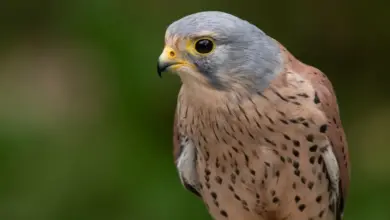African Barbets (Lybiidae); Asian (Megalaimidae)
The African Barbets consist of 42 species ranging from the type genus Lybius of forest interior to the tinkerbirds (Pogoniulus) of forest and scrubland.
They are found throughout sub-Saharan Africa, with the exception of the far south-west of South Africa.
Description
The African barbets are colorful mid-sized to small birds, averaging about 20–25 cm in length.
The tinkerbirds are smaller, ranging down to the Red-rumped Tinkerbird (Pogoniulus atroflavus) which weighs a mere 7 g and averages 9 cm (3.6 inches) in length.
They are plump-looking, with large heads. Their heavy bill is fringed with bristles.
Diet / Feeding
These mostly solitary birds eat a variety of insects and fruit, including figs.
They will also visit plantations and take cultivated fruit and vegetables.
Fruit is eaten whole and indigestible material such as seed pits is regurgitated later. Regurgitation does not usually happen in the nest (as happens with toucans), although tinkerbirds do place sticky mistletoe seeds around the entrances of their nests, possibly to deter predators.
As the other barbets, They are believed to be important agents in seed dispersal.
In addition to fruit, African barbets also take arthropod prey, picked from the branches and trunks of trees.
They are the most insectivorous of all barbets – and take a wide range of insects, cicadas, ants, dragonflies, crickets, locusts, beetles, moths, and mantids. Scorpions and centipedes may also be taken.
Some species will take small vertebrates, such as lizards, frogs, and geckos.
Nesting / Breeding
Some species will nest in riverbanks or termite nests. They nest in holes excavated into a tree.
The average clutch consists of 2 to 4 eggs. Incubation and raising of the young are shared by both parents. The incubation period is about 13 – 15 days.
African Barbet Species
Subfamily Lybiinae
Genus Gymnobucco
- Naked-faced Barbet, Gymnobucco calvus
- Bristle-nosed Barbet, Gymnobucco peli
- Sladen’s Barbet, Gymnobucco sladeni
- Grey-throated Barbet, Gymnobucco bonapartei
Genus Stactolaema
- White-eared Barbet, Stactolaema leucotis
- Anchieta’s Barbet, Stactolaema anchietae
- Whyte’s Barbet, Stactolaema whytii
- Green Barbet, Stactolaema olivacea
Genus Pogoniulus
- Speckled Tinkerbird, Pogoniulus scolopaceus
- Western Green Tinkerbird or Western Tinkerbird, Pogoniulus coryphaeus
- Moustached Green-tinkerbird, Pogoniulus leucomystax
- African Green-tinkerbird, Pogoniulus simplex
- Red-rumped Tinkerbird, Pogoniulus atroflavus
- Yellow-throated Tinkerbird, Pogoniulus subsulphureus
- Yellow-rumped Tinkerbird, Pogoniulus bilineatus
- White-chested Tinkerbird, Pogoniulus makawai
- Yellow-fronted Tinkerbird, Pogoniulus chrysoconus
- Red-fronted Tinkerbird, Pogoniulus pusillus
Genus Buccanodon – Yellow-spotted Barbet
Genus Tricholaema
- Hairy-breasted Barbet, Tricholaema hirsuta
- Red-fronted Barbet, Tricholaema diademata
- Miombo Barbet, Tricholaema frontata
- Pied Barbet, Tricholaema leucomelas
- Spot-flanked Barbet, Tricholaema lacrymosa
- Black-throated Barbet, Tricholaema melanocephala
Genus Lybius
- Banded Barbet, Lybius undatus
- Vieillot’s Barbet, Lybius vieilloti
- White-headed Barbet, Lybius leucocephalus
- Chaplin’s Barbet or Zambian Barbet, Lybius chaplini
- Red-faced Barbet, Lybius rubrifacies
- Black-billed Barbet, Lybius guifsobalito
- Black-collared Barbet, Lybius torquatus
- Brown-breasted Barbet, Lybius melanopterus
- Black-backed Barbet, Lybius minor
- Double-toothed Barbet, Lybius bidentatus
- Bearded Barbet, Lybius dubius
- Black-breasted Barbet, Lybius rolleti
Subfamily Trachyphoninae
Genus Trachyphonus
- Yellow-billed Barbet, Trachyphonus purpuratus
- Crested Barbet, Trachyphonus vaillantii
- Yellow-breasted Barbet, Trachyphonus margaritatus
- Red-and-yellow Barbet, Trachyphonus erythrocephalus
- D’Arnaud’s Barbet, Trachyphonus darnaudii
- Usambiro Barbet, Trachyphonus usambiro
African Barbets Species Images
Also please refer to Tinkerbird Photo Gallery
Beauty Of Birds strives to maintain accurate and up-to-date information; however, mistakes do happen. If you would like to correct or update any of the information or even submit an article or pictures, please contact us. THANK YOU!!!


